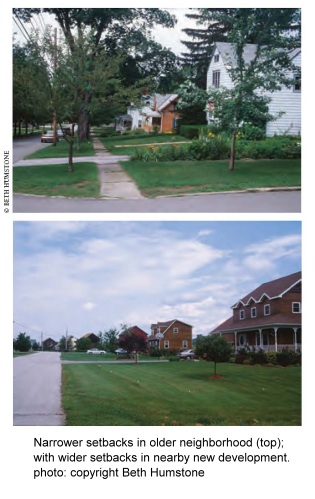Read an excerpt from this article below. You can download the full article by using the link at the end of the excerpt.
Years of sprawl produced communities where land was consumed at a much higher rate than the growth in population. Rather than expand up, out back, or to the side, developers often abandoned urban areas for greenfields where they could start from scratch. Commerce transitioned from multistory buildings on Main Street to one-story stores and offices surrounded by large fields of parking. Spacious industrial parks cropped up with sites for widely separated buildings, each consuming only a small portion of the lot.
Families migrated farther and farther afield looking for more land and cheaper land on which to have a home. Between 1970 and 2007 the median size of a new single-family home grew by 64 percent (from 1,385 square feet to 2,277 square feet) even while household size declined.
Streets followed the trend and soon many new subdivisions had roads wide enough for two fire engines to pass each other between two lanes of parking.
 These patterns are not just the result of consumer preferences or business templates. Zoning and subdivision regulations often mandated large lots, generous setbacks, wide residential streets, and plenty of parking.
These patterns are not just the result of consumer preferences or business templates. Zoning and subdivision regulations often mandated large lots, generous setbacks, wide residential streets, and plenty of parking.
After decades of wide streets, big homes, large yards, and acres of surface parking and big box stores, development may finally be trimming down. The rate of growth in developed land moderated to just a few percentages more than the rate of growth in population between 2002 and 2007. The median size of a new single-family home declined by 6% from its peak in 2007 to 2,135 square feet in 2009. And according to the American Housing Survey, yards are getting smaller too. The median size lot for a single-family home is down in 2009 to .26 acres from .36 acres in 2007.
Many communities have reduced their street width requirements. The State of Oregon has even developed guidelines for “skinny streets.”
Some big box retailers are also rethinking their standard formats and looking into smaller, more neighborhood-oriented stores.
Why are a growing number of families, communities, and businesses now examining smaller options?
For one, demographics have shifted. Today a little over 20 percent of all households consist of two parents with children under 18. As our population ages and households diversify, people are demanding alternatives to single-family homes on large lots out in the countryside — and more are looking at urban neighborhoods, transit-oriented development, or new village-scale projects. Communities are increasingly responding to this demand.
— end of excerpt —
Beth Humstone works as a planning consultant on a wide range of projects in rural communities and small towns. She is an advisor to the National Trust for Historic Preservation; former Executive Director of the Vermont Forum on Sprawl (now Smart Growth Vermont); a past member of the Burlington (VT) Planning Commission; and former Chair of Vermont’s Housing & Conservation Trust Fund Board.
Humstone is co-author, with Julie Campoli and Alex MacLean, of Above and Beyond, Visualizing Change in Small Towns and Rural Areas (APA Planners Press, 2002).
You must be logged in or a PlannersWeb member to download this PDF.